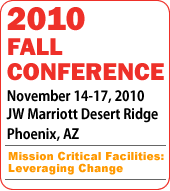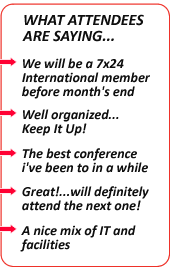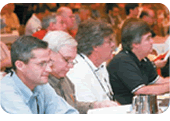 |
 |
 |
7x24 Exchange, Inc.
322 Eighth Avenue, 501
New York, NY 10001-8001
Tel: 646-486-3818
Fax: 212-645-1147
[email protected] |
|
|
10:00 A.M. - 12:00 P.M.
MANAGING, MEASURING AND DRIVING DC PERFORMANCE WORKSHOP
Driving data center performance is an increasingly difficult challenge
in today's rapidly evolving environment. The amount and type of
information that is required to assess performance continues to
expand. During this workshop the presenter will review the
fundamentals of setting up a performance management structure
within your organization. The latest performance management
metrics will be reviewed including an in depth review of the recently
updated PUE metrics released by the Data Center Metrics
Coordination Task Force. The concept of the DC Performance Stack
will be introduced along with real-world examples of best practice
measurement programs.
David Schirmacher, Chief Strategy Officer, FieldView Solutions and Vice President, 7x24 Exchange International
|
|
|
|
|
|
2:30 - 5:00 P.M.
Tutorial A: FLUID MECHANICS 101: FUNDAMENTALS OF COOLING AIRFLOW IN A DATA CENTER
This tutorial session will introduce basic concepts of air velocity,
airflow rate, pressure, and temperature distribution as applied to
raised-floor data centers. You will be shown why the flow distribution
through the perforated tiles is usually not uniform. It is governed by
the air velocity and pressure variation under the raised floor. By
calculating this variation, you can predict the airflow coming out of
each perforated tile.
Such a calculation allows you to study the effect of variables such as:
layout of the CRAC units and the perforated tiles, the height of the
raised floor, and the presence of obstructions under the raised floor.
Once the flow rates through the perf tiles are determined, the next
step is to calculate, in the above-floor space, the air velocity and
temperature as the air moves through the server racks and back to
the CRAC units. Many examples will be presented to develop an
understanding of the physical processes and to draw practical
conclusions.
The tutorial will show how to create a computational model of a data
center layout and calculate the corresponding airflow and
temperature distribution.
Suhas V. Patankar, Ph.D., Professor of Mechanical Engineering, University of Minnesota
and President, Innovative Research, Inc.
|
|
|
|
|
|
2:30 - 5:00 P.M.
Tutorial A: FIRE PROTECTION GAME CHANGERS
New fire protection technologies emerge every 3 to 5 years which
have the potential to significantly impact the industry trends; these
are your "Fire Protection Game Changers." You will learn what these
new technologies are and how they may change your organization's
approach to fire protection for years to come. We will share with you
what the advantages and disadvantages are of these systems
compared to more traditional approaches to fire protection.
Additionally, we will discuss the new hot/cold aisle containment
strategies and how your fire protection systems may be affected.
Steve Carter, Vice President Engineering, Orr Protection
|
|
|
|
|
|
8:30 A.M.
CONFERENCE KEYNOTE: GAME PLAN FOR SUCCESS
This dynamic presentation outlines the game plan
that brought Joe Theismann success both on and
off the football field. Former NFL MVP
quarterback and Super Bowl champion, he reveals
his Game Plan for Success by drawing parallels
between winning in football and in business.
Theismann focuses on how to succeed under
pressure - when it's "4th and 1" - and how to
adapt quickly to unexpected situations - when you're faced with a
"blitz" instead of a "zone." He urges individuals and organizations to
set goals and correct errors each step of the way, an approach that
builds momentum, which, once on your side, would be hard for even
the best "defense" to stop!
Joe Theismann, NFL Legend
|
|
|
|
|
|
10:00 A.M.
UPDATE FROM THE DATA CENTER METRICS COORDINATION TASK FORCE
Accurately reporting overall data center efficiency is a high priority
for many in the industry. Back in January of this year, leaders from
the 7x24 Exchange, ASHRAE, The Green Grid, Silicon Valley
Leadership Group, U.S. DOE Save Energy Now Program, U.S. EPA
Energy Star Program, U.S. Green Building Council, and Uptime
Institute, met in Washington, DC to gain consensus on how to best
apply metrics to measure data center performance. A task force was
established to provided recommendations for measurement and
publishing of data center efficiency using the PUE metric. The task
forced released version 1 of their recommendations document on
July 15th, 2010. Join us as the 7x24 Exchange hosts a discussion
with several members of the task force.
Moderator:
David Schirmacher, Chief Strategy Officer, FieldView Solutions, and Vice President, 7x24 Exchange International
Panelists:
Alexandra Sullivan, Technical Development Manager, ENERGY STAR for Commercial Buildings, EPA
Paul A. Matthew, Ph.D., Staff Scientist, Lawerence Berkeley National Laboratory
Dan Azevedo, SSG Director - Data Center Architecture Strategy and Innovation, Symantec Corporation
W. Pitt Turner, IV, P.E., Executive Director, Uptime Institute
|
|
|
|
|
|
11:30 A.M.
HP - THE ANATOMY OF A SERVER
In the world of Infrastructure, they are just called servers, or maybe
just computers. The fact is, there have been many changes in the
makeup of a server since the days of the old 14U behemoths. But
what is really inside the deepest reaches of a server today? Given
the continued influence Infrastructure has had on the computer
world, many new and somewhat surprising things are going on in
servers now that did not exist only a handful of years ago. Join Ken
Baker for a visual journey through the server of the 21st century,
what it is now, and what it may look like in the future.
Ken Baker, Datacenter Infrastructure Technologist, Hewlett Packard Company
|
|
|
|
|
|
1:45 P.M.
THE MODERN ECONOMICS OF DATA CENTERS WITH DIRECT CURRENT
Syracuse University has just completed an extremely efficient data
center using direct current. DC current allows efficiency gains in
transformation and savings in real estate. Join us to discuss the
business case for DC as well as taking a virtual tour of the facility.
Finally, we can save operational budgets by turning power monitoring
into power management and performing asset management.
Chris Sedore, Chief Information Officer, Syracuse University
Dave Sterlace, Critical Power Segment Manager, ABB
Rudy Kraus, Chief Executive Officer, Validus DC
|
|
|
|
|
|
3:15 P.M. Concurrent Breakout Sessions
Breakout A: BUILDING DAMAGE ASSESSMENT TEAMS
Computing needs continue to grow - and in 2009 there's a
prediction of over 2.5 million server rooms. Server room rack
density has doubled every 8 years since 1992, with
increased density through blade servers, server virtualization,
and consolidation.
A key component of the disaster avoidance/recovery process is the
ability to provide a thorough and quick damage assessment following
an initiating incident. We will show you how Quest Diagnostics using
the National Incident Management System utilized an ICS structure
in developing their cross-functional team. Team used desktop drill to
build element checklists. A full exercise was conducted which tested
each elements checklist and provides for a written damage
assessment and recommendation for declaration within 2 hours of
the event.
James K. Staufenberg, Director Facilities and Network Operations, Quest Diagnostics
|
|
|
|
|
|
3:15 P.M.
Breakout B: LEVERAGING THE CLOUD TO DELIVER AFFORDABLE HIGH-AVAILABILITY
The presentation will focus on understanding how leveraging the cloud computing can improve up-time and guarantee performance. Cloud computing that is hosted, private or public can deliver an affordable solution to your disaster recovery or high-availability strategies within a budget that even your company can stomach. This presentation will not only walk you through various cloud strategies but also give the IT manager the tools to sell it to your management team through a defensible ROI analysis.
Shawn Mills, President, Green House Data
|
|
|
|
|
|
3:15 P.M.
Brakout C: IBM - POWER REDUNDANCY IN DATA CENTERS USING DISTRIBUTED GENERATION
Intersecting trends of data center electric load growth and the
imperative to use less energy present an opportunity for Mission
Critical facilities to apply clean and efficient Distributed Power
Generation technologies to reduce their carbon footprint, reduce
costs, and increase reliability and redundancy.
Dr. Roger R. Schmidt, P.E., Chief Engineer on Data Center Energy Efficiency, IBM
David R. Blair, P.E., President, BHP Energy LLC
Sam Brewer, General Manager, BHP Energy LLC
|
|
|
|
|
|
9:00 A.M.
KEYNOTE: MTECHNOLOGY - QUANTITATIVE RELIABILITY ANALYSIS OF TIER-LIKE DATA CENTER TOPOLOGIES
The purpose of the Uptime Institute's 4-level Tier Classification
system is "for comparing the functionality, capacity, and expected
availability (or performance) of a particular site infrastructure design
topology against other sites." In the ensuing years the Tier system
has been frequently invoked in the design and discussion of missioncritical
facilities. Neal Dowling and Dr. Yoonik Kim of MTechnology
(MTech) constructed schematic diagrams for 4 "Tier Like"
hypothetical data centers, one for each Tier level. We developed
Fault Tree models to evaluate the reliability and availability of each
design. Fault tree models also identify which components in each
system are most likely to participate in system failure. The results of
the analysis are interesting and informative. Using both the MTech
study and a similar study by HP Critical Facility Services, Steve
Fairfax will show that designs reasonable people would agree are the
same Tier level can have markedly different performance.
Conversely, designs with different Tier classifications may have very
similar performance. The presentation should inform the discussions
of the best metrics for measurement of data center performance and
the various design and operating approaches to achieving high
reliability in mission-critical facilities.
Stephen A. Fairfax, President, MTechnology
|
|
|
|
|
|
10:30 A.M.
CLOUD COMPUTING: AN INFORMATION SECURITY PERSPECTIVE
This presentation is a brief introduction to cloud computing that
analyzes the security aspects of the different types of cloud
computing services. Information risks associated with cloud
computing and some of their countermeasures will be discussed.
Cloud computing also has the potential to improve information
security in some cases and examples of this will be covered.
Stephen T. Whitlock, Information Security Chief Strategist, The Boeing Company
|
|
|
|
|
|
11:30 A.M.
Containers Panel - DATA CENTER CONTAINERS GIVE END USERS NEW OPTIONS
As manufacturers continue to introduce new data center containers,
end users find that the new models fit an increasing array of
applications. This panel of experts from Microsoft, HP, IBM, CAT,
Chil-Pak, Active Power and PDI explores the case for using data
center containers in a number of settings, and examines the costs
and reliability issues.
**Following this session attendees will be able to enjoy lunch and view authentic containers provided by PDI and Chil-Pak.
Moderator:
Kevin Heslin, Editor, Mission Critical Magazine
Panelists:
Ken Baker, Datacenter Infrastructure Technologist, Hewlett Packard Company
Steve Wetter, Global Solutions Manager Electric Power Division, CAT
Sam Macrane, Product Manager, Chil-Pak
Kevin Timmons, GM, Data Center Services, Microsoft Data Centers
Tim Cortes, Chief Technology Officer, PDI
|
|
|
|
|
|
1:45 P.M. Concurrent Breakout Sessions
Breakout A: ENHANCING DATA CENTER EFFICIENCY WITH MODULAR CONTAINMENT
We are proposing a customer case study with the University of
Michigan, an innovator in data center efficiency, and AFCO Systems.
In 2009 the University of Michigan, an innovator in data center
efficiency has brought online a newly constructed, efficient North
Campus Data Center (NCDC). This Tier 3 data center uses the
concept of modular containment to run a network that is dedicated to
staying green. Planned and operated by the University of Michigan
Hospitals and Health Centers (UMHHC), the NCDC provides up to
~2.5MW computing capacity in an approximately 15,000 gross
square foot data center. University of Michigan Design Team Leader Mike Mallia, CEO of
AFCO Systems, will give an overview of the design goals for power
distribution, high density cooling via modular containment, innovative
distributed structured cabling and environmental monitoring.
Jack Underwood, IT Manager Healthcare, University of Michigan Medical Center Data Center Operations
Mike Mallia, Chief Executive Officer, AFCO
|
|
|
|
|
|
1:45 P.M.
Breakout B: HPC SUPERCOMPUTING - IS IT IN YOUR FUTURE?
There is an HPC in your future! While super computers are currently
used only by government and research universities, they are likely to
become much more mainstream in the not too distant future. What is
different about HPCs? What will make them more mainstream and
how will this affect the 7 x 24 marketplace? An HPC facility
represents a dramatic diversion from today's data centers. HPCs use
the fastest computers in the world, with massively paralleled
networks of servers. The load density for these sites typically is
between 700 W/sf and 1600 W/sf. The approach to cooling these
loads is daunting and the power distribution requirements equally
impressive. It is not unusual to see a 3 phase 480 volt feed into an
HPC machine. This session will address the emergence of HPCs,
their likely broader use within business and industry, and the forces
that will drive these systems into Colo Data Centers - including the
3D Internet. It will also describe in detail the technical requirements
for housing HPCs and the types of innovative solutions that can be
employed as demand for HPC facilities grows.
Dr. Phil Bording, Associate Professor & Chairperson, Dept. of Computer Sciencebording, Alabama A&M University
Kevin McCarthy, Vice President, EDG2
|
|
|
|
|
|
1:45 P.M.
Breakout C: CISCO - USING THE NETWORK INFRASTRUCTURE TO MONITOR AND MANAGE ENERGY EFFICIENCY
The session will describe, EnergyWise, a new energy control plane
embedded in Cisco switches and routers and available for free to
customers. It will describe the advantages of managing and
monitoring energy, using the network infrastructure, and will include a
demo connecting to one of Cisco labs with terminal and video feed.
Luis Suau, Cisco
Jon Inaba, Director Power Management Solutions, Raritan
|
|
|
|
|
|
3:15 P.M.
UPTIME INSTITUTE - TIER STANDARD: OPERATIONAL SUSTAINABILITY
Tier Standard: Operational Sustainability defines the risk factors and
behaviors beyond Design Topology (Tier) that impact data center
uptime. The three major elements of Operational Sustainability are
Management & Operations, Building Characteristics, and Site
Location. This session will address the industry's need for a standard
such as TS:OS and how the Uptime Institute went about developing
such a standard to guide owners toward the maximum benefit of
their operations budget and staffing resources.
David Humphrey, Senior Consultant, Uptime Institute
|
|
|
|
|
|
8:45 A.M.
KEYNOTE: Innovate or Die! A Thought Provoking Look At Innovation In General
Kevin B. Kealy, GM, Data Center Services, Microsoft Data Centers
|
|
|
|
|
|
10:15 A.M.
ADOBE/BLOOME - ADOBE BEYOND LEED: FROM COMPACT FLUORESCENTS TO FUEL CELLS!
Adobe, Cushman Wakefield and Bloom Energy will discuss Adobe's
progress in energy efficiency as well as recent developments in onsite
power generation. What kick started the process? What has the
progress been to date? What tools have been developed and used in
the process? Why onsite power generation? Incentives? What are the
technical aspects and future of fuel cells? Attendees will walk away
from this session with answers to all of these questions and more.
Randy H. Knox, III, Senior Director, Global Workplace Solutions, Adobe Systems
George Denise, Sr., CFM, CPM, FMA, RPA, LEED AP, Client Solutions, Cushman+Wakefield, on behalf of Adobe Systems
John Reuter, Enterprise Account Executive, Bloom Energy
|
|
|
|
|
|
11:15 A.M.
Using 277V Power Supplies in Servers in the Data Center
Improving energy performance is an important consideration in the design and operation of a data center. A key factor in improving the energy performance of a data center is the reduction of system losses. The server power supply input voltage has a significant impact on the overall energy performance in the data center. This paper focuses on improving energy performance in data centers in North America by utilizing 277V power supplies in servers in the data center.
Jerry Sumrell, Senior Associate, Syska Hennessy Group
Paul Marcoux, SVP, Facilities Group Manager, Branch Banking & Trust Co.
|
|
|
|
|
|

